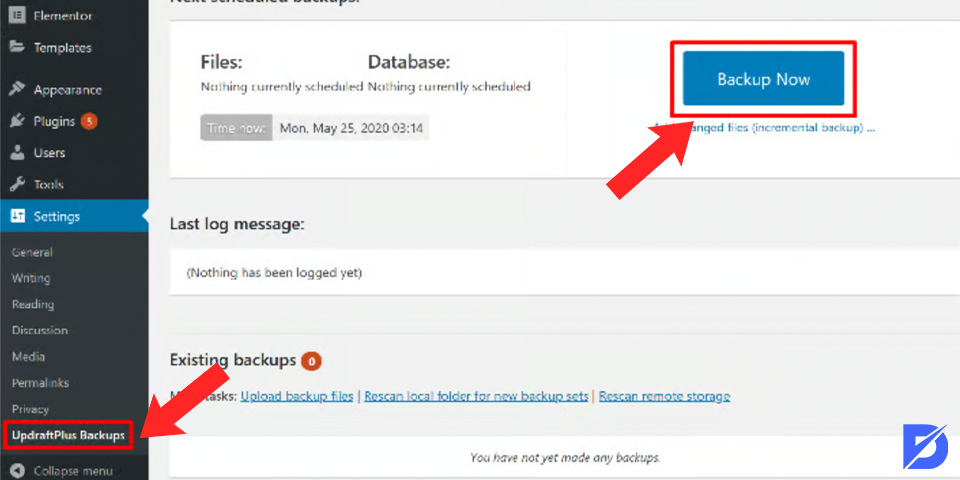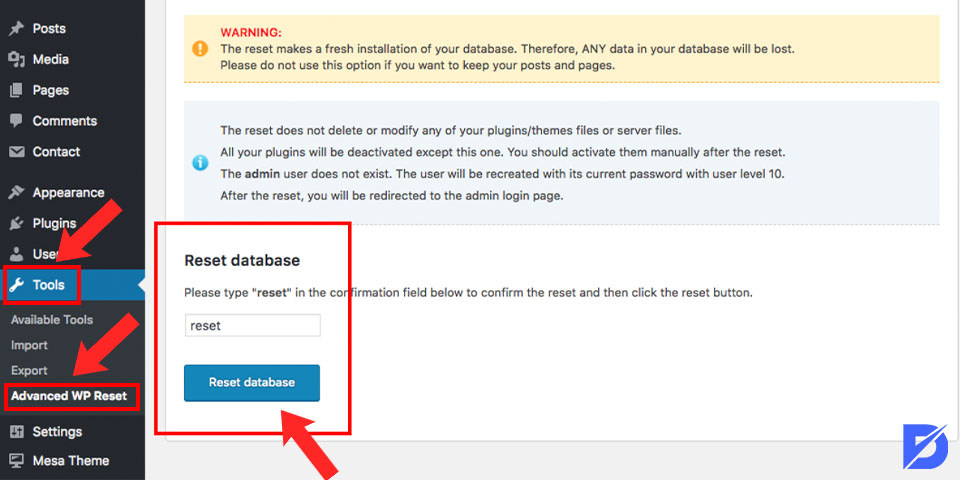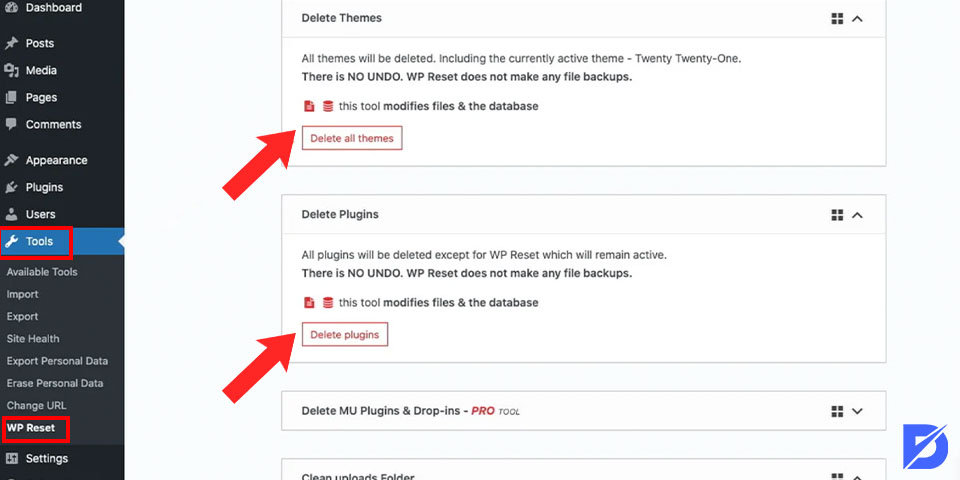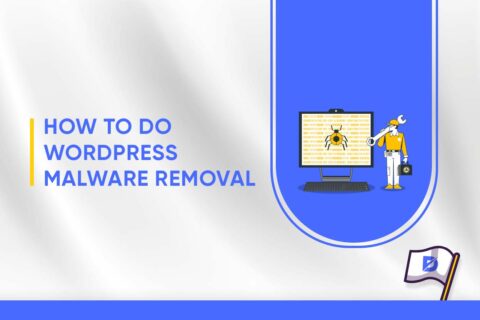Have you ever found yourself in a situation where you wished you could start over with a clean slate on your WordPress website? Manually deleting test data can be tedious and time-consuming, but luckily, there’s an easier way.
Reasons to Reset Your WordPress Website
Resetting a WordPress site refers to the process of returning a WordPress website to its default, freshly installed state. This means removing all the content, themes, plugins, and customizations you’ve added to the site, essentially starting over from scratch. There are several reasons why you might want to reset and learn how to reset a WordPress site. In several situations, resetting your WordPress site to its default settings can be beneficial. It’s especially useful if you use the site for practice and learning as you explore WordPress functionalities. Another scenario where a reset can be helpful is during a significant website redesign. When you are working on overhauling a client’s website or your own, you might have already created and tested the new design on a staging site.
Furthermore, if your WordPress site has been compromised and you suspect malicious code or spam in various files, a reset can help eliminate the threat quickly. Instead of manually searching for and removing the malicious elements, starting afresh can be a more efficient solution. However, while resetting your WordPress site can be advantageous in these scenarios, it’s essential to be cautious about using the reset option. In some situations, a reset might not be the best course of action, and we will discuss those in the following sections.
How to Reset a WordPress Website
Enter a WordPress Reset plugin, a powerful tool that allows you to revert your site back to its initial default state in just a few seconds. But what exactly does it mean to reset the WordPress site? It’s like restoring the factory settings of a smartphone, taking your site back to the fresh installation state with no customizations.
Preparing for a WordPress Reset
One effective way to prepare for a WordPress reset is by utilizing WP-CLI, a powerful tool that facilitates various WP-related tasks, including creating new WP instances, theme and plugin updates, and, most importantly, backup and restoration of your CMS. Configuring WP-CLI for backups will provide you with a safety net, allowing you to confidently proceed with your WordPress reset knowing that your data is securely backed up and can be restored if needed.
Backing Up Your WordPress Website
Before resetting your WordPress website, it is crucial to recognize that the process will result in completely removing all customizations and settings. As a precautionary measure, creating a website backup is highly recommended, either manually or by utilizing a reliable WordPress backup plugin. This backup ensures that you can restore your site to its previous state if you have second thoughts or encounter any issues during the reset process.
- By running the command “php wp-cli.phar db export databasefile.sql” the database will be efficiently dumped as an SQL file and stored in the directory of your WP instance, providing you with a complete backup of your website’s critical data.
- To ensure a comprehensive backup of your WordPress website, you’ll need to secure the files of your WP engine, themes, and plugins and make a backup of your database. Using the WP-CLI tool, you can export your database as an SQL file, which will be stored in the directory with your WordPress instance.

- Performing a WP export generates an XML file containing essential content elements like authors, terms, posts, comments, and attachments. This XML backup is useful if you ever need to recreate your WordPress site with previous content.
- Once both backups are generated, you can zip the folder containing your WordPress instance along with the exports. Creating a compressed backup file ensures efficient storage and portability. It’s crucial to keep your backup files in a secure location, whether on your local computer or a remote server.
- For safekeeping, you can use secure file transfer methods like SCP to move the backup to another server or upload it to cloud storage services like Dropbox or Amazon S3.
Creating a Checklist of Important Content and Settings
Before proceeding with the process of resetting your WordPress website, it is crucial to create a comprehensive checklist of important content and settings to safeguard your valuable data. Resetting WordPress will result in the complete removal of all customizations and settings, so taking precautionary measures is essential.
Different Methods to Reset Your WordPress Website
You have two options to reset your WordPress website: a manual reset or a WP reset plugin. Regardless of your chosen method, be aware that both approaches will lead to deleting your posts, pages, settings, plugin configurations, and theme files. It’s crucial to exercise caution before proceeding, as the process cannot be undone once completed.
- You’ll need to undertake several steps to manually reset your WordPress site.
- First, you’ll delete your existing database and create a new one. Next, you’ll proceed to remove all plugins, themes, and other files from your WordPress installation.
- Finally, you’ll rerun the WordPress installation script to start afresh.
Resetting WordPress Using a Plugin: WP Reset
Resetting your WordPress website using the WPReset plugin is a simple and efficient process. With over 400,000 downloads, WP Reset offers a user-friendly interface and customizable reset options.
- To get started, install and activate the plugin in your WordPress dashboard.
- Once activated, navigate to Tools > Advanced WP Reset. If you don’t have this plugin, you can learn how to install WordPress plugins.

- In the Site Reset section, type “reset” in the box and click the “Reset Site” button.
- A pop-up will appear, asking you to confirm the reset. Click “Reset WordPress” to proceed.
The advantage of using the WP Reset plugin is that you can keep your username and passwords intact and have the option to reactivate themes and plugins after the reset. Furthermore, the plugin lets you take snapshots for comparison purposes, giving you complete control over your website. Remember that using the plugin will delete WP content on your site.
Taking snapshots with WP Reset
With WP Reset, you can take snapshots of your WordPress website at specific points in time, which is a valuable feature. These snapshots are like saved states of your site, capturing everything from its configuration to themes, plugins, and content at a particular moment. By taking snapshots before making significant changes or updates, you can quickly revert to a previous state if needed. This process helps you avoid potential disasters caused by errors or conflicts during site modifications. WP Reset records the current state of your site and stores it for future use.
Deleting Themes and Plugins Using WP Reset
WP Reset is a handy plugin if you go through the WordPress reset theme and plugin implementation from the website and reset it to its default state.

- Installing the WP Reset plugin from the official WordPress repository and accessing it from your WordPress dashboard.
- Go to the “Themes & Plugins” section, click the “Delete Themes” button to remove all existing themes, and then click the “Delete Plugins” button to do the same for plugins.
Manual WordPress Reset via the Database
If you prefer not to use a plugin to reset your WordPress website, you can do a manual reset. Although it may take more time and effort, it will give you a better understanding of the WordPress installation basics.
To manually reset your WordPress site, follow these steps:
- Log in to cPanel and go to the Databases section.
- Click on MySQL Databases and locate your WordPress database, then delete it.
- Create a new database with a name of your choice.
- Add a user to the new database, selecting your previous username with its permissions.
- In cPanel, access File Manager and delete the wp-content folder containing plugin and theme files.
- Once you finish these steps, your website will be reset. However, to make it functional again, you need to restart WordPress and rerun the WordPress installation script.
- To do this, type your domain name in the browser’s address bar and add /wp-admin/install.php at the end. Then, fill out the required form with your site title and username, and click “Install WordPress” after completing it. Use your username and password to log in.
Using a WordPress Staging Environment for Reset
If you want to change your WordPress website without affecting the live version, a staging environment is a useful tool. This will allow you to observe the effects of your changes and ensure everything is working correctly. Take the time to review your changes and make any necessary adjustments in the staging environment.
- To begin, duplicate your live site in the staging environment using your hosting provider’s feature or a staging plugin.
- Once you have a copy, you can perform a reset either manually or using a plugin.
Post-Reset Checklist and Considerations
Before proceeding with a reset WordPress to default, following a comprehensive checklist is essential to ensure a smooth and successful process. By adhering to the following checklist, you’ll be well-prepared for a successful WordPress reset without any unexpected issues.
- Firstly, create a complete backup of your website’s files and database to safeguard your content, settings, and configurations, allowing you to restore them if necessary.
- Take note of the plugins and themes currently installed, as you’ll need to reinstall them after the reset; ensure compatibility with your current WordPress version.
- To preserve specific content, like posts, pages, and media, consider using the WordPress export feature for easier importation post-reset.
- Document any customizations made to your theme or CSS, so you can easily reapply them later.
- Remember to save a copy of your current wp-config.php file containing critical settings and database connection details.
- Remove unnecessary plugins and themes to reduce potential conflicts and improve performance after the reset. Verify user roles and permissions, especially for multiple users on your site.
- If your website integrates third-party services or APIs, keep their API keys or credentials handy for reconfiguration after the reset.
- Take note of custom menus and widgets to recreate them later.
- After the reset, double-check your site’s URLs and permalinks to ensure they are correctly set up.
- Temporarily disable caching plugins to prevent conflicts during the reset process.
- If your website is accessible to multiple users or the public, notify them about the upcoming reset and any potential downtime.
- Thoroughly test your website’s functionality, including pages, posts, forms, and interactive elements, to verify everything works correctly post-reset.
- Finally, ensure you have the latest version of WordPress, themes, and plugins installed to keep your website up-to-date and secure.
Updating WordPress and Plugins
Regularly updating your WordPress installation and plugins is essential for maintaining a secure and efficient website. These updates provide you with the latest features, bug fixes, and security patches, which reduce the risk of vulnerabilities and potential security breaches. By routinely checking for updates and quickly applying them, you can ensure your WordPress site remains optimized, dependable, and safeguard against potential threats.
Reinforcing Website Security Measures
Enhancing your website’s security measures is important to protect it from potential cyber threats. To strengthen website security, you can implement various preventive measures to safeguard sensitive data and maintain the integrity of your online platform. This includes using strong and unique passwords, enabling two-factor authentication, regularly updating software and plugins, employing a web application firewall, and conducting regular security audits.
Reinstalling and Configuring Essential Themes and Plugins
After resetting your website to its default settings, it is important to reinstall and configure the essential themes and plugins. These elements are crucial for the functionality and design of your WordPress site. You should carefully select and install the necessary themes and plugins from trusted sources, such as the WordPress repository or reliable third-party providers.
Final Thoughts on Resetting Your WordPress Website
When used thoughtfully and with proper consideration, resetting your WordPress website can be a powerful implementation. It allows you to test new themes, plugins, and configurations without fearing irreversible changes, offering a fresh start. This process is particularly valuable for developers and website owners who want to experiment with or fix issues without the burden of manual cleanup. Whether you choose to reset with a plugin or manually, it’s important to understand the implications and have a post-reset checklist to make the most of this process. By using resetting wisely, you can streamline your website development and maintenance, ensuring a robust and secure WordPress site for the long run.
Frequently Asked Questions About
When you reset your WordPress website, it reverts the site’s database to its original installation settings while leaving the files untouched. As a result, all customizations and content will be deleted in the process.
Yes, you can reset your WordPress site without losing themes and plugins using a reset tool. This tool only works for single resets, not multisite configurations. Your plugins, themes, and settings remain untouched, but customized database content will be deleted. Files and user accounts are unaffected.
Yes, it is possible to undo a WordPress reset. If you change your mind after restoring an older version of your content, you can easily go back to the revisions interface and restore it again. Restoring a previous revision does not delete other revisions, so you have the flexibility to revert back and forth as needed.





No comments to show.